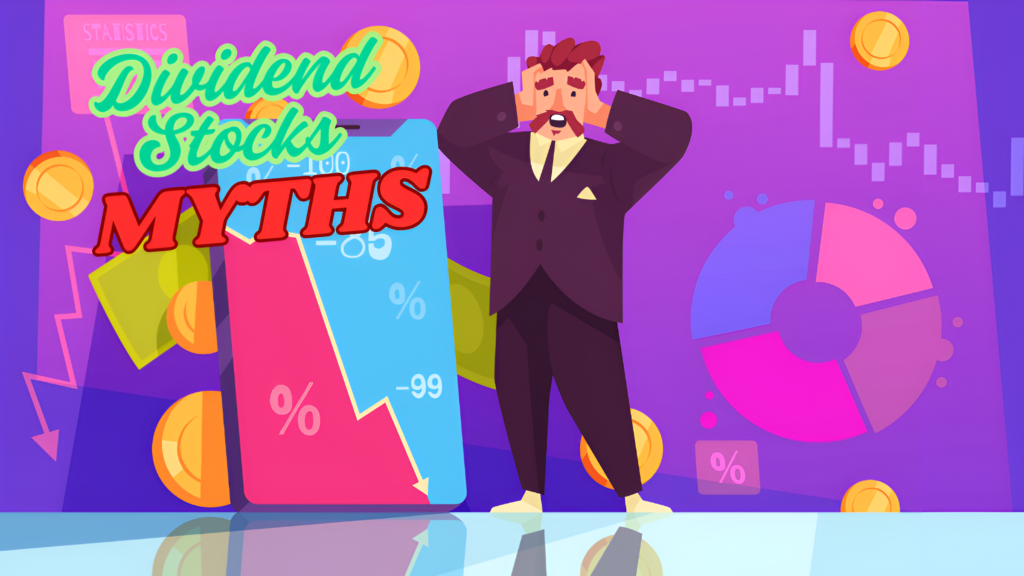Introduction
Dividend stocks are often seen as a cornerstone of income-focused investing. These stocks distribute a portion of a company’s earnings to shareholders, making them an attractive option for long-term wealth accumulation. However, there are several myths and misconceptions that prevent investors from fully appreciating the benefits of dividend stocks. In this article, we will debunk some of the most common myths surrounding dividend stocks.
Myth #1: Dividend Stocks Are Only for Retirees
One of the biggest misconceptions about dividend stocks is that they are only suitable for retirees or conservative investors. While it’s true that retirees favor dividend-paying stocks for a steady income, these stocks can also benefit younger investors.
Reality: Reinvesting dividends can accelerate wealth accumulation through compounding. Younger investors can take advantage of dividend reinvestment plans (DRIPs) to buy additional shares and increase their holdings over time.
Myth #2: Provide Guaranteed Income
Many investors assume that dividends are guaranteed once a company starts paying them. However, dividends are not set in stone and can be reduced or eliminated if the company faces financial difficulties.
Reality: While many blue-chip companies have a strong track record of paying dividends consistently, economic downturns or unexpected business challenges can force companies to cut or suspend dividends.
Myth #3: High Dividend Yields Indicate Better Investments
Investors often gravitate toward stocks with the highest dividend yields, assuming that a high yield means a better investment. However, an unusually high dividend yield can sometimes signal financial distress.
Reality: A high dividend yield may result from a declining stock price rather than strong financial performance. It’s crucial to analyze the company’s fundamentals and payout ratio to ensure that the dividend is sustainable.
Myth #4: Do Not Offer Capital Appreciation
Some investors believe that dividend-paying stocks do not appreciate in value as much as growth stocks. This misconception leads to the assumption that dividend stocks are only for income generation, not wealth growth.
Reality: Many dividend stocks, especially those in sectors like technology and consumer goods, offer both dividend payments and capital appreciation. Companies that consistently grow earnings often see their stock prices rise over time.
Myth #5: Are Risk-Free Investments
Some investors assume that dividend stocks are a safer investment compared to non-dividend-paying stocks. While dividend stocks may offer a level of stability, they are not entirely risk-free.
Reality: Dividend-paying companies can face industry disruptions, economic downturns, or regulatory changes that impact their stock prices and dividend payouts. A diversified portfolio that includes both dividend and growth stocks can help mitigate risks.
Myth #6: All Dividend Stocks Are the Same
Some investors think that all dividend stocks function similarly, offering consistent payouts and similar benefits. However, dividend stocks can be categorized into different types.
Reality: There are dividend aristocrats, dividend growth stocks, and high-yield stocks, each with distinct characteristics. Dividend aristocrats, for example, are companies that have consistently increased dividends for decades, while high-yield stocks may come with greater risk.
Myth #7: Are Not Suitable for Growth Investors
A common belief is that growth investors should avoid dividend stocks because they focus on capital appreciation rather than income.
Reality: Many companies, particularly in the technology and healthcare sectors, offer both growth potential and dividend payments. Dividend growth stocks, in particular, provide investors with the best of both worlds—income and appreciation.
Myth #8: Companies That Pay Dividends Don’t Reinvest in Growth
Some investors assume that companies paying dividends are not reinvesting in their business, limiting their growth potential.
Reality: Many companies balance dividend payments with strategic reinvestments. Dividend-paying giants like Apple and Microsoft continue to invest in innovation while rewarding shareholders with dividends.
Myth #9: You Need a Large Investment to Benefit from Dividend Stocks
Another misconception is that only wealthy investors can benefit from dividend stocks because significant capital is required for meaningful income.
Reality: With fractional shares and DRIPs, investors can start small and gradually build a portfolio of dividend-paying stocks. Over time, reinvested dividends and additional contributions can lead to substantial returns.
Myth #10: Dividend Investing is Outdated
Some investors believe that dividend investing is an outdated strategy, especially in an era of high-growth technology stocks.
Reality: Dividend investing remains relevant as it provides consistent returns, helps hedge against market volatility, and offers compounding benefits over time. Even tech companies are increasingly offering dividends as they mature.
Conclusion
Dividend stocks offer numerous advantages, from steady income to compounding growth. However, myths and misconceptions can prevent investors from fully leveraging their benefits. By understanding the realities of dividend investing, investors can make informed decisions and build a robust portfolio. Whether you are a retiree, a young investor, or someone looking to diversify, dividend stocks can be a valuable addition to your investment strategy.
FAQs
Q. What Is a Dividend Aristocrat?
- A dividend aristocrat is a company that has consistently increased its dividends for at least 25 consecutive years.
Q. Can Dividend Payments Be Reinvested?
- Yes, many companies offer Dividend Reinvestment Plans (DRIPs), allowing investors to use dividends to buy more shares.

Owner of Paisewaise
I’m a friendly finance expert who helps people manage money wisely. I explain budgeting, earning, and investing in a clear, easy-to-understand way.


Kudos to you for sharing your individual experiences; it makes a personal touch to your content.
I admire how you simplify complex ideas into easily understood bits of knowledge. Well done!
I’m definitely going to share this write-up with my friends and audience.
Pingback: Can You Live Off Dividends Alone? - Paisewaise
Pingback: Can I Make Passive Income from Stocks? - Paisewaise